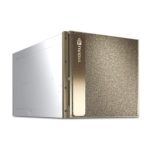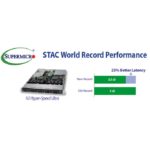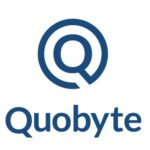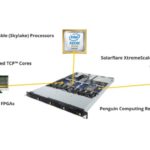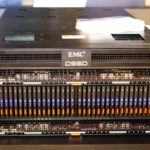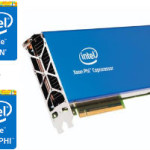Today NVIDIA announced record performance on STAC-A3, the financial services industry benchmark suite for backtesting trading algorithms to determine how strategies would have performed on historical data. “Using an NVIDIA DGX-2 system running accelerated Python libraries, NVIDIA shattered several previous STAC-A3 benchmark results, in one case running 20 million simulations on a basket of 50 instruments in the prescribed 60-minute test period versus the previous record of 3,200 simulations.”
Supermicro, Red Hat, and Solarflare Set World Record STAC Performance
Today Supermicro announced a new world record for lowest latency on the well-known STAC-N1 benchmark. “This benchmark was performed on a pair of Supermicro SYS-1029UX-LL1-S16 servers, each with dual 8-core Intel Xeon Scalable 6144 (Gold) processors overclocked at 4.18GHz. The servers were also loaded with Red Hat’s Red Hat Enterprise Linux 7.5 operating system and Solarflare X2522 Adapters. Compared to all prior publicly released STAC-N1 results, the bare metal system demonstrated the lowest mean latency of 2.3 microseconds at both the base rate (100k messages per second) and the highest rate tested (1 million mps).”
Quobyte Joins STAC Benchmark Council to help Financial Services Solve Storage Challenges
Today hyperscale storage provider Quobyte announced that it has accepted an invitation to join the Securities Technology Analysis Center (STAC) Benchmark Council, an influential group of technologists in the finance industry. “Quobyte provides massively scalable software storage to allow the industry to take advantage of the insights they can gain from the extensive amount of historical trading data they have collected,” said Björn Kolbeck, Quobyte’s CEO and Co-Founder. “We’ve found that Quobyte storage software running on a cluster of industry standard whitebox servers can significantly reduce time spent on backtesting — literally converting time saved into money.”
“The Ultimate Trading Machine” from Penguin Computing sets Record for Low Latency
The world of High Frequency Trading is all about reducing latency to make money. At the recent STAC Summit in Chicago, a Penguin Computing device called The Ultimate Trading Machine achieved a record-low 98 nanosecond tick-to-trade latency, some 18% faster than the previous world record. “Facing tremendous pressures to optimize the transaction lifecycle, the financial services industry helps drive innovations in many core technologies. At Penguin Computing, we empower our customers with with open technology solutions that achieve performance requirements while keeping costs low and avoiding vendor lock-in. We are proud to join with our partners to deliver this Ultimate Trading Machine.”
Kx Breaks STAC Benchmark Record with Dell EMC DSSD D5
‘Trading firms in the STAC Benchmark Council designed the STAC-M3 suite to represent a range of performance challenges that are common in financial time-series analysis,” said Peter Lankford, Director of STAC. “As data volumes grow and as the query demands from quants, machines, and regulators increase, it is more important than ever for tick database solutions to perform well at scale. Kx’s kdb+, running on Dell EMC DSSD D5 and PowerEdge servers, has established performance records while testing on the largest STAC-M3 data scale so far.”
Supermicro World Record STAC-2 Performance with Intel Xeon Phi
Today Supermicro announced World Record STAC-A2 performance. Announced at the STAC Summit, Supemicro beat the record with their SYS-1028GR-TR server supporting dual Intel Xeon Haswell EP processors and dual Intel Xeon Phi 7120P coprocessors.
DDN Sets World Record STAC Performance
Today DDN announced record performance on the Securities Technology Analysis Center (STAC) benchmark. Using the company’s EXAScaler storage solution, DDN set new public records for multiple workload types and sizes, including large and small workloads as well as I/O and compute-intensive workloads.
New STAC Benchmark: Nvidia Tesla K80 GPU
Today STAC released audited STAC-A2 Benchmark results for a server using the just-announced Nvidia Tesla K80 dual-GPU Accelerator board.

